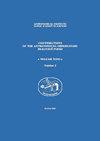好的,坏的和真正丑陋的:复合光谱双星
IF 0.2
4区 物理与天体物理
Q4 ASTRONOMY & ASTROPHYSICS
Contributions of the Astronomical Observatory Skalnate Pleso
Pub Date : 2020-03-01
DOI:10.31577/caosp.2020.50.2.574
引用次数: 0
摘要
复合光谱双星(包含一个低温的巨型主星和一个热矮星副星)应该是对理论家祈祷的回答。由于它们的光度差异,这两种光谱在近紫外光区都是可见的,这一区域包括几个有价值的光度和温度指标。如果我们只测量这颗次级恒星在不同日期的径向速度(RV),并构建一个SB2轨道,我们就能立即得到组成恒星的质量比。对矮行星的质量进行猜测,就可以得到冷巨星的质量——这是一种独特而极有价值的方法。但只是测量热矮星的RV??它提出了许多问题,主要是由恒星的性质引起的。热矮星(b晚期或A早期)的谱线很少,大多数谱线都很弱,它们会因旋转而变得非常模糊,并且会被巨矮星拥挤的光谱所掩盖。光谱减法可以很好地分离两种光谱,但剩余的光谱不可避免地会有很大的噪声。然而,45颗最亮的北方复合光谱双星中有一半以上的结果已经公布;大约六分之一是三重系统,其中一些系统具有任何理论家都无法解释的特征。一些“坏”,因为他们巨大的初选有高亮度和找到一个匹配标准减法过程麻烦,而“真的丑”包括一个明星在一个简单的SB2二进制和一段时期的75年,一对早期小矮人在为期3天的100公里的轨道与振幅年代−1,显示绝对没有转动扩大,而另一个是谁的二级(显然是一个明星),质量是其主要的两倍大。但其中8个样本也发生了重叠,并表现出极其重要的色球吸收现象——这些是“真正好的”系统。谈话中列举了各种例子。本文章由计算机程序翻译,如有差异,请以英文原文为准。
The good, the bad and the really ugly: composite-spectrum binaries
Composite-spectrum binaries (containing a cool giant primary and a hot dwarf secondary) should be an answer to a theoretician’s prayer. Because of their luminosity difference, both spectra are visible in the near UV, a region that includes several valuable luminosity and temperature indicators. If we just measure the radial velocity (RV) of the secondary at different dates, and construct an SB2 orbit, we immediate get the mass ratio of the component stars. A guess of the mass of the dwarf, and one thence obtains the mass of the cool giant – a unique and immensely valuable method. But just measure a hot dwarf’s RV?? It raises many problems, mostly caused by the nature of the star. A hot (late-B or early-A) dwarf has few lines, most are weak, they can be very blurred by rotation, and they get hidden by the crowded spectra of the giant. Spectral subtraction works a treat in separating the two spectra, but the residue is inevitably rather noisy. Nevertheless, results from well over half of the 45 brightest northern composite-spectrum binaries have been published; about 1 in 6 are triple systems, and a few have characteristics that defy any theoretician to explain. Several are ‘bad’ because their giant primaries have high luminosity and finding a matching standard for the subtraction process is troublesome, while the ‘really ugly’ include an Am star in a simple SB2 binary with a period of 75 years, a pair of early-A dwarfs in a 3-day orbit with amplitudes of 100 km s−1 and which show absolutely no rotational broadening at all, and another whose secondary (apparently a single star) is more that twice as massive as its primary giant. But 8 of the sample are also eclipsing, and manifest the hugely important phenomenon of chromospheric absorption – those are the ‘really good’ systems. The talk showed examples of each kind.
求助全文
通过发布文献求助,成功后即可免费获取论文全文。
去求助
来源期刊
CiteScore
1.10
自引率
20.00%
发文量
4
审稿时长
>12 weeks
期刊介绍:
Contributions of the Astronomical Observatory Skalnate Pleso" (CAOSP) is published by the Astronomical Institute of the Slovak Academy of Sciences (SAS). The journal publishes new results of astronomical and astrophysical research, preferentially covering the fields of Interplanetary Matter, Stellar Astrophysics and Solar Physics. We publish regular papers, expert comments and review contributions.

 求助内容:
求助内容: 应助结果提醒方式:
应助结果提醒方式:


